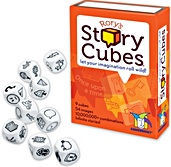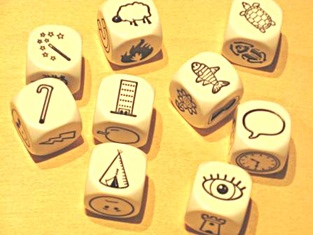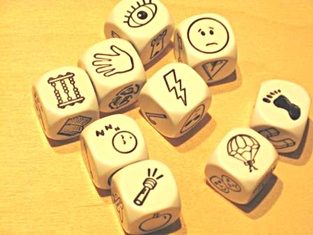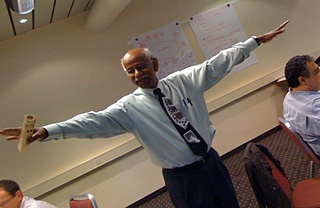THIAGI GAMELETTER:
February 2011
SERIOUSLY FUN ACTIVITIES FOR TRAINERS, FACILITATORS,
PERFORMANCE CONSULTANTS, AND MANAGERS.
TABLE OF CONTENTS
Masthead
Our mission statement, copyright notice, and cast
of characters.
Live Online Learning Activity
Online SDLT
Online discussion on autopilot.
Jolt
Eye Test by
Tracy Tagliati
You should have your eyes examined.
Improv
Catch All by
Tracy Tagliati
Think on your feet.
Say It Quick
Room to Wiggle by
Brian Remer
Real life is not binary.
Discoveries
“Tell me a story!” by
Brian Remer
Nine pictures generate endless
stories.
Ideas
When Randomness Rules by
Brian Remer
Inject some randomness.
Activities
What's Your Story? by
Brian Remer
Create your own story—and share
it.
Dallas Workshops
Interactive Techniques for Instructor-Led
Training
Public workshops in the USA.
Zurich Workshops
Thiagi and Sam in Zurich
Public workshops in Europe.
Single Topic Survey
Mnemonics by
Tracy Tagliati
Do you remember…?
Survey Results
Humor at Work by
Tracy Tagliati
A summary of your responses.
Check It Out
Training Games Network ( http://TrainingGamesNetwork.com/ )
An online community for our readers.
Masthead
THIAGI GAMELETTER:
SERIOUSLY FUN ACTIVITIES FOR TRAINERS, FACILITATORS,
PERFORMANCE CONSULTANTS, AND MANAGERS.
Mission
To increase and improve the use of interactive,
experiential strategies to improve human performance in an
effective, efficient, and enjoyable way.
Editorial Roster
 Author and Editor
: Sivasailam (Thiagi) Thiagarajan
Author and Editor
: Sivasailam (Thiagi) Thiagarajan
 Assistant Editor
: Raja Thiagarajan
Assistant Editor
: Raja Thiagarajan
Associate Editors: Jean Reese and Tracy Tagliati
Contributing Editors: Brian Remer and Matthew Richter
Editorial Advisory Board: Bill Wake, Matthew Richter, Samuel van den Bergh, and <type your name here>
Copyright Info
The materials in this newsletter are copyright 2011 by The
Thiagi Group. However, they may be freely reproduced for
educational/training activities. There is no need to obtain
special permission for such use as long as you do not
reproduce more than 100 copies per year. Please
include the following statement on all reproductions:
Reprinted from THIAGI GAMELETTER. Copyright © 2011
by The Thiagi Group, Inc.
For any other use of the content, please contact us (
thiagi@thiagi.com ) for permission.
Subscription Info
To sign up, or to donate and help us continue this
newsletter, please see the Online
Newsletter page on our website (
http://thiagi.com/pfp.html ).
Feedback Request
Thiagi believes in practicing what he preaches. This is an
interactive newsletter, so interact already! Send us your
feedback, sarcastic remarks, and gratuitous advice through
email to thiagi@thiagi.com . Thanks!
[Table of
Contents]
Live Online Learning Activity
Online SDLT
For nearly a year now, we have been fortunate to conduct a
monthly online training session sponsored by the Training
Magazine Network (and ably coordinated by Gary VanAntwerp). In
the process, we learned (and relearned) several useful
things:
- There's wisdom in groups. The group as a whole knows
more than you do.
- Webinars can and should incorporate activities.
- There is a big difference between online training
sessions (webinars) for groups of less than 20 and groups of
more than 50.
- Most participants have varying amounts of expertise and
experience on most training topics.
- Most participants are also capable of taking a basic
idea and working out details of transfer and application. By
explaining too much, trainers deny opportunities for
participants to share what they know and how they plan to
use it.
Based on these principles, we have created an online
structured sharing activity incorporating the concept of
Self-Directed Learning Teams (SDLT). Here's the flow of this
activity.
Flow
Brief the participants. Explain that you
are going to help the participants explore 30 different
techniques for reducing the amount of trainers' talk and
increasing the amount of participants' learning. Point out
that some of your participants will know more than others
about each specific technique. Announce that you are going
to conduct an activity that encourages people to share what
they know and what they want to know.
Encourage different types of comments.
Explain that you will briefly describe one technique at a
time—and keep your mouth shut. Invite participants to
type their comments related to the technique. Suggest
different comments based on responses to these types of
questions:
- What excites you about this technique?
- Have you ever used or experienced this
technique?
- What additional details do you know about this
technique?
- How would you use this technique?
- What aspects of this technique make you
uncomfortable?
- Why will it not work for you?
- How would you modify this technique to better suit
your needs?
Explain the two-group system. Point out
that during most online chats, participants focus on typing
a whole slew of comments so that they don't have time to
read other people's comments. To prevent this from
happening, you are going to divide the participants into two
groups of approximately equal size. During the discussion of
a specific technique, one group (known as the commentators)
will type their comments. The other group (known as readers)
will keep their hands off the keyboard. Instead of typing
their own comments, they will carefully read, process, and
organize the comments made by the other team. They will make
a mental note of the more interesting comments. During the
discussion of the next technique, the groups will change
their roles: The commentators will become the readers and
the readers will have their turn at typing comments.
Explain the time limit. To prevent the
discussions from going on and on, announce a 3-minute time
limit. Encourage the participants to manage their time
wisely and stay on task.
Divide participants into two groups.
Explain that one group will be called the AM group and the
other will be called the NZ group. Participants whose last
names begin with the letters A through M belong to the AM
group. The rest of the participants (with their last names
beginning with the letters N through Z) belong to the NZ
group. Explain that for the discussion of the first
technique, the AM group will act as commentators and NZ
group will act as the readers.
Display a brief description of the first
technique. Project a slide with the description
of the first technique. Don't insult the participants by
reading aloud what's on the screen. Tell the AM group, “Go
to it,” and invite the NZ group to sit back, relax,
read, and process the comments.
Conclude the first discussion. Read the
typed comments as the conversation progresses. Keep an eye
on the timer. Announce a 30-second warning. Conclude the
session at the end of 3 minutes.
Invoke the Ziegarnik principle. Give your
rationale for the somewhat arbitrary conclusion: According
to Bluma Ziegarnik, people remember unfinished business
longer than finished business. Also, the brain needs to
incubate the ideas that are already generated, rather than
fill up with more ideas.
Make your comments. Reinforce useful and
accurate comments made by the group. If any of the comments
are misleading, make gentle corrections.
Repeat the process. Move on to the next
technique. Ask the groups to exchange their roles of
commentators and readers. Display the next technique and ask
the NZ group members to conduct their typed discussion.
Continue the activity. About an hour will
be the suitable time for this activity. Stop the activity 5
minutes before the scheduled closing time. Explain that you
are going to conclude the session. Give the participants the
complete list of the 30 techniques and explain that they may
continue exploring these ideas.
A Sample
Here's the first technique that we displayed on the
screen:
ABLA: Assessment Based Learning Activity. Administer a
test. Those who answered an item correctly teach those who
did not. If nobody answered an item correctly, then you
(the trainer) teach.
Here are some of the comments that this technique
elicited:
- I once had someone administer the MBTI instrument
and walk the participants through a
self-scoring-and-interpretation process. Is this an
example of ABLA?
- More active, participant centered. All learn from
each other.
- Beginning with a test is not good for adults.
- Increased learner involvement.
- Participants just share their ignorance.
- Won't work with all topics.
- Will work with factual learning and computational
skills.
- Needs quality control.
- Boring!
- Opportunity to hear stories from other
participants.
- Making sure that content is understood.
- Use open-ended questions. No incorrect answers.
Everyone discusses.
- How can we ensure that everyone gets the same
information?
Variations
- This approach can also be used in a face-to-face
setting. We will describe such an application in the next
issue of the newsletter.
- Instead of briefly describing different techniques, we
can use a variety of other discussion triggers:
- Principles
- Research results
- Pithy sayings
- Guidelines and ground rules
- Instead of short discussions of different items, we
can schedule a lengthier discussion of a single
item.
[Table of
Contents]
Jolt
Eye Test
by
Tracy Tagliati
 I think I read about this activity in Dan
Gilbert's book Stumbling on Happiness,
but I am not able to find the exact location. This jolt
demonstrates that people are able to perform better when they
believe that things are getting better.
I think I read about this activity in Dan
Gilbert's book Stumbling on Happiness,
but I am not able to find the exact location. This jolt
demonstrates that people are able to perform better when they
believe that things are getting better.
Synopsis
Participants take one vision test using a traditional eye
chart and record their results. Then they take a second
vision test using an eye chart which has the letters printed
in the reverse order (from the smallest to the largest) and
record their new results.
Purpose
To explore the impact of increasing or decreasing levels of
difficulty on individual performance.
Participants
Two or more.
Time
3 minutes for the activity, 2 minutes for the
debriefing.
Supplies
Two Eye Test Charts (37K PDF). Page 1
is a “traditional” chart, with letters that start large
and finish small. Page 2 is an “inverted” chart, with
letters that start small and finish large.
Preparation
Print the charts.
Attach the charts on the wall at the average participant's
eye level.
Measure 20 feet away from the chart and mark this spot on
the floor.
Flow
First Round
Participants take the eye test. Ask the
participants to pair up with someone. Ask Partner A to
cover one eye, stand at the mark on the floor, and read
aloud the letters on each line of the chart. Partner B
will check Partner A's performance and make a note of the
line at which Partner A inaccurately identifies more than
50 percent of the letters.
Partner B's turn. Now partner B covers
one eye, stands on the mark, and reads the letters on each
line. Partner A checks the eye chart for accuracy and
makes a note of the line at which the partner misses more
than 50 percent of the letters.
Second Round
Change eye charts. Replace the previous
eye chart with the inverted chart that has small letters
at the top of the chart and progressively larger letters
at the bottom.
Partners repeat eye exam as before. Use
the same procedure to jot down the line at which each
partner makes more than 50 percent errors.
Debrief
Ask the participants to compare the first eye exam with the
second eye exam. Ask them if they were able to read smaller
letters during the first round or the second one. (In most
cases, participants will be able to read smaller letters
during the second round when the letters are arranged from
the smaller to the larger sizes.)
Ask the participants why they think they were able to read
smaller letters when they knew the task was getting
easier.
Invite participants with an opposing point of view to share
their opinions and present some evidence to support
them.
Ask participants to speculate on the training applications
of the principle of proceeding from the hardest to the
easiest.
Learning Point
People perform better when they know things are getting
easier, not more difficult.
[Table of
Contents]
Improv
Catch All
by
Tracy Tagliati
 Here's an energizer that gives your
participants an opportunity to think on their feet and see how
others act under pressure.
Here's an energizer that gives your
participants an opportunity to think on their feet and see how
others act under pressure.
Time
5 to 10 minutes.
Equipment
Koosh ball (or some other soft thing that can be thrown and
caught).
Flow
- Ask participants to stand in a circle.
- Pick a category such as a product, service, issue, or
any topic relevant to what was discussed in the
workshop.
- Throw the ball to a participant.
- The participant who catches the ball must say
something relevant about the topic.
- After saying something, the participant throws the
ball to another participant.
- Continue this process for 5 minutes.
- Change the category and play the game again.
[Table of
Contents]
Say It Quick
Room to Wiggle
by
Brian Remer
This month, randomness enhances creativity beginning with
this 99-Word Story.
Room to Wiggle
The steam room at the “Y” has just one switch: on or
off. Flip the switch and wait. Is it really on? Something
must be happening deep inside the plumbing guts of the
health club but you don't know what until a spray of steam
shoots into the small room. That's when you know it's
“on.”
A binary system is OK for computers, but in real life there
is wiggle room. A lot can happen between on and off, left
and right, liberal and conservative.
How often do we needlessly confine ourselves to only two
options?
[Table of
Contents]
Discoveries
“Tell me a story!”
by
Brian Remer
 If you've ever
heard this request and been stumped after, “Once upon a
time,” you already have a reason to try out Rory's Story
Cubes: nine dice featuring 54 iconographic pictures that are
sure to evoke a tale. Roll them across the table and string
them together to weave a one-of-a-kind story.
If you've ever
heard this request and been stumped after, “Once upon a
time,” you already have a reason to try out Rory's Story
Cubes: nine dice featuring 54 iconographic pictures that are
sure to evoke a tale. Roll them across the table and string
them together to weave a one-of-a-kind story.
Story Cubes come in a pocket-sized box convenient to bring to
any social event, team meeting, or just to keep handy whenever
you need some extra inspiration or fun. Roll all nine cubes
and make a story or deal the dice and let people roll one on
their turn to advance the story. If you are teaching, announce
a theme related to the training topic and challenge people to
tell a story that fits. Roll the cubes and create a story
about how your team solved a problem or marketed a particular
product. Take them to your next coaching session and ask your
protégé to tell a story about how to address a
burning issue. Keep a few cubes in your pocket and roll a
story to inspire your next project.
The uses for these cubes and the stories they evoke are
endless—especially when you realize the tiny pictures
can be used both at face value and metaphorically. The images
are flexible enough to be enjoyed by a variety of ages,
abilities, and cultural backgrounds. Once you hold them in
your hand, you'll want to tell a story too!
Rory's Story Cubes by Gamewright: http://www.gamewright.com/gamewright/index.php?section=games&page=game&show=247
[Table of
Contents]
Ideas
When Randomness Rules
by
Brian Remer
Stories can be an economical way to share information, convey
an idea, enhance memory, rehearse new concepts, and have fun.
Several other issues of this newsletter have been devoted to
the value stories can add to learning and creativity. In
addition, the 99-Word story that begins each month's entry is
an example of how stories can set the stage by providing a
grounded context.
Rory's Story Cubes offer an interesting twist to the value of
stories. By introducing a random roll of the dice, players
have an added challenge for their creative muscles. They've
got to somehow make connections between improbable concepts.
The result can be more inventive, surprising, relevant.
The effect of chance is a key ingredient for any creative
process because it allows for the introduction of new ideas.
It's a detour around the rut we usually travel; an antidote
for the quotidian. As this month's 99-Word Story suggests, a
lot more can happen when there is room to wiggle than we might
suspect. And where there's room to wiggle, there's space for
random activity as well.
If you're ever stuck with a problem, figure out a way to
inject some randomness. Let it rule, at least for a short
while, then see what new opportunities develop. And when you
hit upon the novel, please share your discovery (email Brian)!
[Table of
Contents]
Activities
What's Your Story?
by
Brian Remer
Now I'll pass Rory's Story Cubes to you! I've already rolled
the dice. You simply choose one of the photos below for your
turn. Put the dice in any order you wish for your tale then
write it up and send me
an e-mail. Want an added challenge? Connect your
story to a current problem or issue in your workplace. I'll
post it on the sample page.
I hope to read your story soon! Have fun!
Story Cubes, Roll Number One!

Read a sample story.
Story Cubes, Roll Number Two!

Read a sample story.
[Table of
Contents]
Dallas Workshops
Interactive Techniques for Instructor-Led
Training

Here's
your chance to attend Thiagi and Tracy's Interactive
Techniques for Instructor-Led Training Workshop.
Attend the fourth day and become a certified Thiagi
trainer.
You can find more about the workshops in our detailed brochure (194k PDF).
If you register by February 25th, you save $250 for the
3-day workshop and $115 for the 1-day certification
program.
When
March 28-30, 2011
March 31, 2011 for the 1-day certification program
Where
Courtyard by Marriott Dallas Central Expressway
10325
North Central Expressway
Dallas, TX 75231
USA
(214) 739-2500
Planning on staying at the hotel? We have blocked off a
limited number of rooms at a discounted rate of $99. Mention
“The Thiagi Group” to get the best price when booking
your room, or ask for our sales coordinator, Julia Wolkin.
She will take good care of you. Phone: 214-622-1013, Email:
Julia.Wolkin@marriott.com .
How Much
3-Day Workshop (March 28-30, 2011): $1,495.
1-Day Certification Workshop (March 31, 2011): $495
Early Bird Discount
If you register before February 25,
2011
- 3-Day Workshop (March 28-30, 2011): $1245 (save
$250)
- 1-Day Certification Workshop (March 31): $380 (save
$115)
Group Discount
Groups of three or more who enroll at the same time will
get a 15 percent reduction on their registration fees.
Two Easy Ways to Register
Online. Visit our online store at
thiagi.com and click on “Workshops: 2011”. (You will automatically be
given the early bird discounted fee.)
Telephone. Call (812) 332-1478.
Need More Information?
Check out our detailed brochure (194K PDF) or call Tracy at
(805) 494-0948 .
[Table of
Contents]
Zurich Workshops
Thiagi and Sam in Zurich
 Van den
Bergh Thiagi Associates are happy to offer their tenth annual
workshops in Winterthur, Switzerland (near Zurich).
Van den
Bergh Thiagi Associates are happy to offer their tenth annual
workshops in Winterthur, Switzerland (near Zurich).
Workshop 1: Interactive Training Strategies
June 21-23, 2011 (three days)
This workshop is designed for trainers, instructional
designers, facilitators, managers, and performance
consultants. The workshop helps a wide range of
practitioners, from newcomers to experienced specialists, to
master skills and concepts related to different types of
training games, simulations, and learning exercises.
This workshop practices what it preaches. Participants
learn new principles and procedures and apply them to
creating and conducting different types of learning
activities that meet their training objectives, audiences,
and needs.
Workshop 2: Design Clinic and Advanced Interactive
Strategies
June 24-25, 2011 (two days)
This workshop is designed for participants who have
completed Thiagi's 3-day Interactive Training Strategies
workshops.
The workshop design strongly incorporates the individual
needs of the participants. At present Thiagi suggests the
following three major components:
- A design clinic in which Thiagi and Sam will provide
consultative advice and feedback on interactive training
activities that you are currently designing (or planning
to design).
- Peer review and support that uses structured
strategies to encourage you to present your ideas, plans,
and problems to your fellow participants and receive
valuable feedback and guidance.
- Advanced sessions on interactive strategies and
facilitation techniques. Selected topics will include
facilitating multinational and multicultural groups,
online games, interactive webinars, positive psychology
activities, and intrinsic motivation.
Bonus: The workshop will provide you with
a software package for designing online games and train you
how to use it.
More Information
For more information, please download our detailed brochure (615k PDF)
[Table of
Contents]
Single Topic Survey
Mnemonics
by
Tracy Tagliati
 How many of you remember these rhymes:
How many of you remember these rhymes:
Thirty days have September…
In 1492, Columbus sailed…
or the acrostic for the musical notes on the Treble clef:
Every good
boy does
fine
As you know from experience, these catchy little mnemonic
devices can help learners recall critical information.
While some trainers find mnemonics to be effective for
recalling information, others are reluctant to use them
because of the time it takes to learn the mnemonics and the
additional time spent applying them.
How about you?
Poll Question
Do you use mnemonics in your training?

(The poll opens in a new window.)
Open Question
What are some of your favorite rhymes, acrostics, or
other mnemonics?

(The survey opens in a new window.)
You may include your name along with your response, or if
you prefer, keep it anonymous.
Here are some favorite mnemonics from colleagues:
Aaron: I find that the sillier and the
most absurd mnemonic devices work the best. My favorite
mnemonic is an acrostic that I use to help our foreign
employees familiar with American currency:
“Why do Jealous
Leaders Have
Jovial Girl
Friends?” The letters of the words
help recall the denomination: W = Washington $1, J =
Jefferson $2, L= Lincoln $5, H= Hamilton $10, J= Jackson
$20, G = Grant $50, and F = Franklin $100.
Tina: Encoding verbal information in a
mnemonic device takes time—sometimes more time than
it would take to just remember the information in the first
place. However, I think mnemonics are a great investment in
time when the participants will be using the information
regularly. The one I used recently is an alliteration I
learned from Thiagi: The four C's of game design:
Contrivance, Conflict, Control, and Conclusion.
Carolyn: I train in an industry that
relies heavily on numbers, and I think numbers can be the
toughest challenge to remember. Since my participants are
very familiar with phone texting, I use the telephone keypad
to build acrostics to help them remember numbers. In this
case, each number is matched with the first letter
associated with it on the keypad: #2 is A , #3 is D, #4 is
G, #5 is J, #6 =M, #7 = T, and 9 = W. Since the number one
and zero don't have letters associated with them on the
keypad, I have assigned 0 =Z (the last number is assigned
the letter), and #1 is I (because the #1 resembles the
letter I).
Using this mnemonic, the number 7,591,207 becomes: Thomas,
the Japanese Walrus, Invited Annabelle, the Zebra, for
Tea.
[Table of
Contents]
Survey Results
Humor at Work
by
Tracy Tagliati
 Last month we asked if you like to use
humor in your training. It turns out that you, the readers of
the Gameletter, are a funny group of people. In
fact, 100 percent of you responded with a resounding, “Yes,
we love using humor in our training!”:
Last month we asked if you like to use
humor in your training. It turns out that you, the readers of
the Gameletter, are a funny group of people. In
fact, 100 percent of you responded with a resounding, “Yes,
we love using humor in our training!”:

(Percentages reflect 106 votes received by February 1,
2010.)
If there are any of you out there who are still a little wary
about using humor in training you may what to continue
reading. Here are some of the practical guidelines, tips, and
recommendations that your fellow readers shared last
month:
Response 8) Humor must be relevant to the group and to the
context. More importantly, the trainer must be viewed as
“human” and “credible”, i.e. someone who knows
the subject, who is comfortable enough with himself or
herself, and who can laugh at himself or herself!
Response 13) Amusing tales about ourselves can help bridge
the distance and differences between the facilitator and
participants. There is a caveat to this: Women need to be
careful of this practice. Research that I have found states
that self-deprecation helps make men more approachable.
However, when women do the very same thing, they can be
viewed as less competent. As a result of this, I am mindful
to tell amusing stories about successes rather than
failures. If I do tell of a mistake I made, I always share
the solutions or the recovery.
Response 28) Self-deprecating humor is a great tool. I use
it to set an example of openness as well as to set my
participants at ease that even though I am the facilitator,
I still have much to learn.
Response 19) Make sure humor is not done at the expense of
any individual or group.
Response 29) Let it be natural. Don't try to force humor if
it isn't doesn't occur naturally with the flow of the
class.
See more
readers' responses or add your own.
Thank you for your responses.
[Table of
Contents]
Check It Out
With a lot of help from our friends Ray Jimenez and Gary
VanAntwerp, we are happy to announce the launch of Training
Games Network, http://TrainingGamesNetwork.com/ an online
community dedicated to learning games and performance
improvement.
It will be difficult for us to describe all the different
ways in which this platform for social learning and networking
will facilitate the exchange of ideas and resources among
members of this community. However, here’s a brief summary of
some of the useful features:
-
Webinars
— Enjoy free webinars and workshops with industry
leaders.
-
Discussions
— Share ideas, challenges and resources with
colleagues.
-
Network
— Connect and build a personal network of
relationships and resources.
-
Groups
— Join or form a group focused on its members' common
needs, interests, and ideas.
-
Case Studies and Best Practices
— Download handouts and references for your
library.
-
Podcasts
— Listen to interviews with industry leaders.
Webinars
Here are four Webinars scheduled for the near future:
- 100 Ways To Use Stories for Learning by Ray Jimenez
(February 10, 2011, 1 PM Eastern)
- Let’s Get Serious about Gaming by Thiagi and Tracy
(February 24, 2011, 1 PM Eastern)
- Seven Techniques for Using Mnemonics in Training by
Tracy (March 4, 2001, 1 PM Eastern)
- $6MM Game: An Action Learning Approach to Leadership
by Matthew Richter (March 11, 2011, 1 PM Eastern)
Discussion Groups
You may enroll in the following groups:
- Creating Games and Puzzles
- Storytelling and Performance
- Action Learning
- Face-to-Face and Online Games
- Facilitation Techniques
- Games To Impact Performance
- Live Online Learning Activities
- Really Rapid Instructional Design
- Using Puzzles as Training Tools
And if none of these groups excite you, you can very easily
create a group of your own.
There are lots more things happening in this online
community. The best way to learn about them is to register
(for free) by visiting the Training Games Network ( http://TrainingGamesNetwork.com/ ).
See you at the community!
[Table of
Contents]
 Author and Editor
: Sivasailam (Thiagi) Thiagarajan
Author and Editor
: Sivasailam (Thiagi) Thiagarajan Assistant Editor
: Raja Thiagarajan
Assistant Editor
: Raja Thiagarajan I think I read about this activity in Dan
Gilbert's book Stumbling on Happiness,
but I am not able to find the exact location. This jolt
demonstrates that people are able to perform better when they
believe that things are getting better.
I think I read about this activity in Dan
Gilbert's book Stumbling on Happiness,
but I am not able to find the exact location. This jolt
demonstrates that people are able to perform better when they
believe that things are getting better. Here's an energizer that gives your
participants an opportunity to think on their feet and see how
others act under pressure.
Here's an energizer that gives your
participants an opportunity to think on their feet and see how
others act under pressure. Reprinted from the
Reprinted from the  Reprinted from the
Reprinted from the  If you've ever
heard this request and been stumped after, “Once upon a
time,” you already have a reason to try out Rory's Story
Cubes: nine dice featuring 54 iconographic pictures that are
sure to evoke a tale. Roll them across the table and string
them together to weave a one-of-a-kind story.
If you've ever
heard this request and been stumped after, “Once upon a
time,” you already have a reason to try out Rory's Story
Cubes: nine dice featuring 54 iconographic pictures that are
sure to evoke a tale. Roll them across the table and string
them together to weave a one-of-a-kind story.


 Van den
Bergh Thiagi Associates are happy to offer their tenth annual
workshops in Winterthur, Switzerland (near Zurich).
Van den
Bergh Thiagi Associates are happy to offer their tenth annual
workshops in Winterthur, Switzerland (near Zurich).

